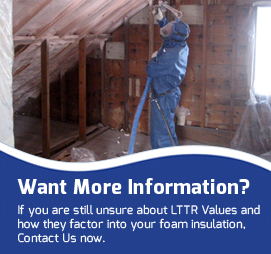LTTR Long Term Thermal Resistance
Recently there has been a great deal of discussion and debate between foam companies concerning LTTR. What the customer must ask and understand is really a two-part question. The first part is what is LTTR? And, secondly, how does this term factor into the actual quality of the foam and the quantity required?
Firstly, the abbreviation LTTR means " long term thermal resistance". This basically means that after the foam has been installed into the building, it will have a particular aged R value (RSI) and will remain at that R value. For example, if you want a value of R-20 of polyurethane foam installed in your home, it may initially be a value of R-22 or R-24 but after a few years may drop to a value of R-20.
This is where LTTR gets confusing. Manufacturers in the industry all promote their foam to be the best foam available. So they market a Type 1 versus a Type 2 foam
How do they do that you ask? Let's go back to LTTR and further explain this. Type 1 foam must have an RSI rating of 1.8 or greater, whereas a type 2 foam requires an RSI rating greater than 2.0. Quite simply, an RSI of 1.8 requires slightly more foam to achieve an R-20 value than does a foam with a 2.0 RSI rating.
The following is a calculation to explain further:
Lets do Type 1 first. Remember this is always tested on a 2 inch thick sample. Because RSI is metric we will convert to an R value.So you take the RSI rating (1.8) at a two inch thickness and multiply it by 5.678 to get its R-value which equals 10.22. You then must divide the 10.22 by 2 to get 5.1 of R-value per inch.
Now, if you want to achieve an R-value of 20, you would then divide 20 by 5.1, which equals 3.9.
Therefore, you would require 3.9 inches of this particular Type 1 foam to achieve an R-20 value. See chart below.
Now lets perform the same calculation for the Type 2 foam:
If the LTTR is 2.0, multiply it by 5.678. This equals 11.35 at 2 inches.
Divide by 2 and this equals an R-value of 5.67 per inch.
Again, if you wanted to achieve an R-value of 20 you would then divide that by 5.67 (3.52 inches). Remember all foams have different LTTR numbers, so the R-values will also be varied. See chart below.
Finally, to answer the second part of our initial question...how does this factor into the actual quality of the foam and the quantity required? Very simply stated, one contractor may be required to install an additional 1/8 of an inch of foam to achieve the same R-value as another.
Remember this, as long as the foam being installed into your home is a CCMC certified foam and conforms to the CHave anadian standards of CAN/ULC S 705.1and CAN/ULC S 705.2 you're good to go.







